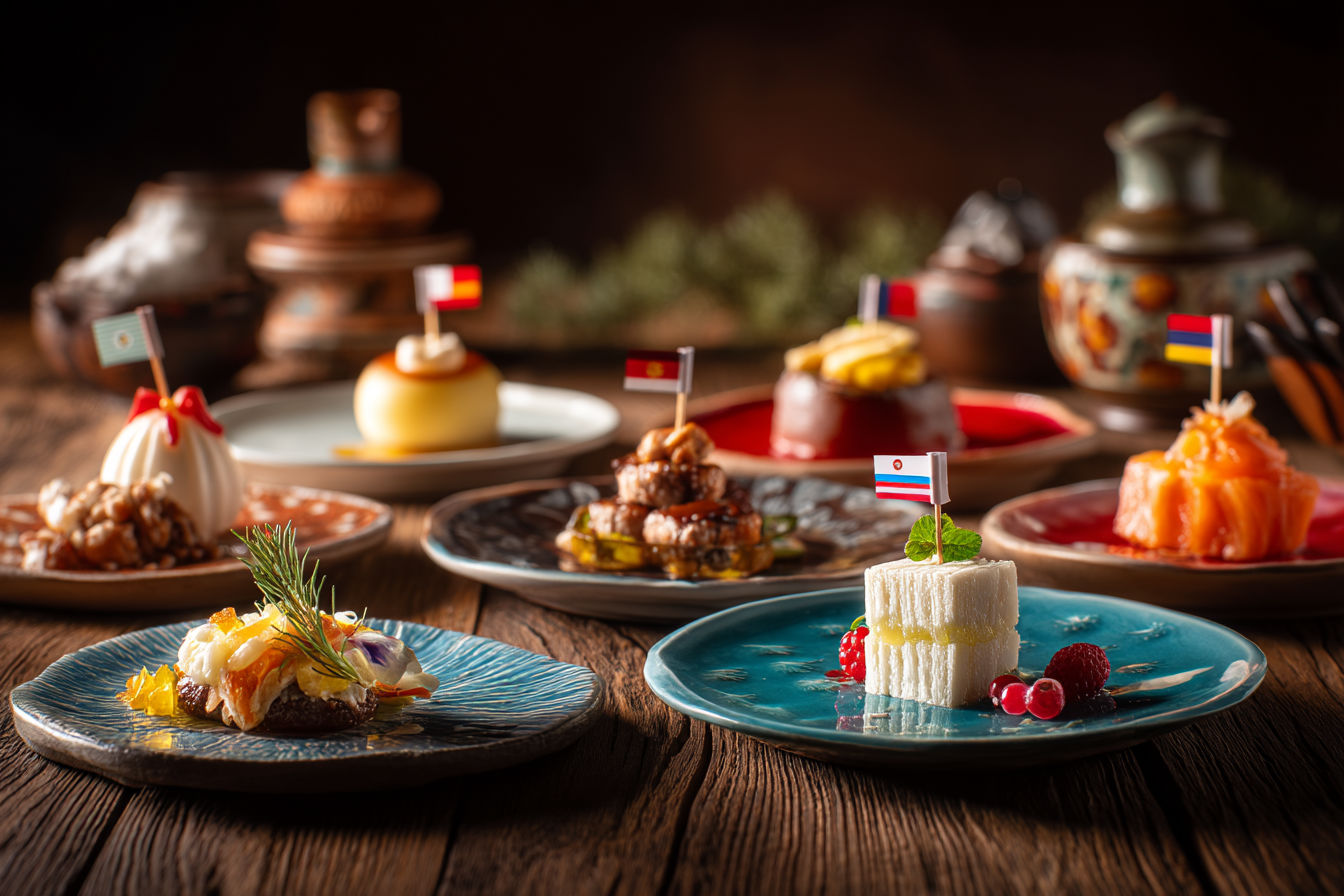This post may contain affiliate links. If you make a purchase through these links, we may earn a commission at no additional cost to you.
Your taste buds may instinctively recoil at the thought of black pepper in chocolate cake or potato chips as a cake ingredient. Yet across the globe, bakers have discovered that the most unexpected combinations often yield the most memorable desserts. These strange concoctions challenge our preconceptions about what makes a delicious cake, proving that culinary boundaries exist to be broken.
This exploration of unconventional cakes dives into the world of weird yet wonderful flavor combinations that somehow work brilliantly together. From savory ingredients that transform into sweet delights to international oddities that might sound strange to Western palates, these cakes deserve recognition for their surprising deliciousness.
The Psychology Behind Unusual Food Combinations
What makes bizarre food pairings taste so good? This culinary phenomenon has roots in both psychology and food science. When unexpected flavors combine successfully, they create what food scientists call “flavor complexity”—a multidimensional taste experience that engages different parts of our palate simultaneously.
Contrasting elements often work together beautifully. The principle of sweet and salty (think chocolate-covered pretzels) or sweet and sour (lemon desserts) proves this point perfectly. Our brains enjoy the novelty and stimulation of these contrasts, creating a more memorable eating experience than single-note flavors might provide.
Food scientist Barb Stuckey explains that successful weird food combinations often balance the five basic tastes—sweet, salty, sour, bitter, and umami. When done correctly, these unusual pairings create harmony rather than discord. That’s why ingredients that sound terrible together might actually create a surprisingly cohesive flavor profile when properly balanced.
Savory Ingredients Gone Sweet
Olive Oil Cake
Replacing butter with olive oil might seem bizarre in a sweet dessert, but Italian bakers have long known this secret. Olive oil adds a complex, fruity depth that butter simply cannot match. The resulting texture becomes remarkably moist with a tender crumb that stays fresh longer than conventional butter cakes.
What makes this cake truly special is how the olive oil’s slight bitterness and peppery finish complement sweet elements like citrus zest or vanilla. Premium olive oils with grassy or fruity notes create the most interesting flavor profiles, turning what could be a simple cake into something sophisticated and unexpected.
Rosemary Lemon Cake
Herbs belong in dinner, not dessert—or so conventional wisdom suggests. This cake proves otherwise. Fresh rosemary infuses the batter with piney, aromatic compounds that remarkably complement the bright acidity of lemon. The herb’s resinous quality cuts through sweetness, creating a balanced dessert that avoids cloying territory.
The magic happens during baking, when the rosemary’s essential oils bloom in the heat. This process transforms what might seem like an awkward savory intrusion into an elegant flavor companion for the citrus. The unexpected herbal notes make this cake particularly appealing to those who typically find traditional desserts too sweet.
Tomato Soup Cake
This Depression-era oddity sounds like a desperate pantry experiment, yet continues to maintain a devoted following. The cake uses condensed tomato soup as a primary ingredient, creating a spiced dessert reminiscent of carrot cake. The tomato’s natural acidity and umami work surprisingly well with warm spices like cinnamon, cloves, and nutmeg.
The soup’s concentrated tomato solids provide moisture and structure while its subtle fruitiness (tomatoes are fruits, after all) complements the sweet elements. Often frosted with cream cheese icing, this bizarre creation demonstrates how savory ingredients can successfully cross into dessert territory when paired with complementary flavors.
Bacon Maple Cake
The bacon dessert trend might seem like a modern indulgence, but this sweet-savory combination taps into deep culinary wisdom. Salt enhances sweetness—a principle this cake exploits brilliantly. Crispy bacon bits provide textural contrast and smoky saltiness against the sweet maple backdrop, creating an irresistible balance.
What makes this cake work is how the maple flavor bridges the gap between meat and dessert. The distinctive woodsy sweetness of maple syrup shares aromatic compounds with bacon’s smoke, creating a natural flavor affinity that makes this bizarre pairing taste surprisingly cohesive rather than disjointed.
Black Pepper Chocolate Cake
Adding ground black pepper to chocolate cake sounds like a recipe disaster, yet this combination has historical precedent in Mexican chocolate traditions. The pepper’s heat amplifies chocolate’s complexity without overwhelming it. Specifically, black pepper contains piperine compounds that stimulate the same receptors as certain compounds in dark chocolate.
The peppery bite appears as a pleasant warming sensation rather than harsh spiciness. This unexpected background heat transforms an ordinary chocolate cake into something mysterious and sophisticated, with layers of flavor that unfold as you eat. The pepper also enhances the fruitiness present in quality chocolate, creating a more nuanced dessert experience.
Vegetable-Based Surprise Hits
Avocado Lime Cake
Avocados in cake might sound strange until you consider their buttery texture and mild flavor. This fruit (botanically speaking) contributes incredible moisture and richness while reducing the need for dairy fats. The avocado’s natural creaminess creates a velvety texture that conventional cakes struggle to achieve.
The key to this cake’s success lies in pairing avocado with lime. The bright citrus cuts through the avocado’s richness while complementing its subtle grassy notes. The result is a beautifully balanced cake with a striking natural green color that tastes sophisticated rather than simply weird. Health-conscious eaters appreciate the nutritional benefits, while flavor-seekers enjoy its unique taste profile.
Sweet Potato Marshmallow Cake
This cake cleverly transforms the beloved Thanksgiving side dish into dessert form. Sweet potatoes contribute earthy sweetness and stunning orange color while providing moisture that keeps the cake fresh for days. Their natural sugars caramelize during baking, creating complex flavor compounds that plain sugar cannot match.
The genius twist comes from incorporating toasted marshmallow elements, either in the frosting or as a filling. This addition creates a nostalgic flavor connection to sweet potato casserole while adding textural interest. The combination works because both elements share compatible sweet profiles while offering contrasting textures.
Carrot Cake’s Weird Cousins: Parsnip and Zucchini Cakes
Carrot cake opened the door for other vegetable-based cakes that sound strange but taste wonderful. Parsnip cake delivers a sweeter, more aromatic version of carrot cake, with the root vegetable’s distinctive spicy notes complementing traditional warm spices. Zucchini cake, meanwhile, provides incredible moisture while letting other flavors shine.
These vegetable cakes succeed because they follow a simple principle: vegetables with natural sweetness or neutral flavors absorb and complement the cake’s spices and sweeteners. They also contribute valuable moisture and texture that creates a more interesting eating experience than plain flour-based cakes.
Beet Red Velvet Cake
Before artificial food coloring became common, red velvet cake achieved its distinctive hue from a chemical reaction between cocoa powder and vinegar. Modern beet-based versions return to natural coloring while adding nutritional value and moisture. The earthiness of beets actually enhances the subtle chocolate notes in traditional red velvet.
What makes this variation successful is how the beets’ natural sugars caramelize during baking, creating depth that artificial coloring cannot provide. The resulting cake maintains the expected vivid color while offering a more complex flavor profile. When paired with tangy cream cheese frosting, the beet’s earthiness disappears into a harmonious whole.
International Oddities
Japanese Mochi Cake
This fusion creation combines Western cake structure with the distinctive chewy texture of Japanese mochi rice cakes. The glutinous rice flour creates an addictively bouncy texture that continues to surprise even after multiple bites. Unlike conventional cakes that pride themselves on lightness, mochi cake celebrates its dense, chewy character.
What makes this cake exceptional is its textural experience. The slight resistance followed by yielding softness creates an eating experience entirely different from traditional Western cakes. Typically flavored with subtle additions like black sesame, matcha, or coconut, these cakes demonstrate how texture can be as important as flavor in creating memorable desserts.
Filipino Ube Cake
The vibrant purple color of ube (purple yam) cake often leads first-timers to expect grape or berry flavors. Instead, this Filipino staple delivers a subtle nutty, vanilla-like taste that defies easy description. The root vegetable creates a uniquely colored cake that needs no artificial dyes to make a visual impact.
The cake’s unusual appeal comes from ube’s ability to contribute color and texture without overwhelming sweetness. This property allows bakers to create a more balanced dessert where complementary flavors like coconut milk or condensed milk can shine. The resulting cake tastes familiar yet exotic, bridging cultural flavor expectations.
Chinese Salted Egg Yolk Cake
Perhaps the strangest entry on this list, salted egg yolk cake incorporates preserved duck egg yolks into a sweet context. These preserved yolks, common in Chinese cuisine, contribute a uniquely rich savoriness that cuts through sweetness. The salted yolks create pockets of umami complexity against the sweet cake backdrop.
The success of this bizarre combination relies on proper balance. When done correctly, the salted yolks provide just enough contrast to make each bite interesting without overwhelming the dessert elements. Often paired with complementary flavors like coconut or pandan, this cake demonstrates how traditional preserving techniques can create entirely new dessert experiences.
Thai Tea Cake
Thai tea’s distinctive orange color and spiced flavor profile translate beautifully into cake form. The tea’s unique blend of Ceylon tea, star anise, cardamom, and tamarind seed creates a complex base that ordinary vanilla cake can’t match. The characteristic orange hue (traditionally from food coloring but achievable with natural colorings) makes this cake visually distinctive as well.
What makes this cake work so well is how the tea’s tannins provide subtle bitterness that balances the sweetness. This balance, coupled with the aromatic spices infused into the tea, creates a sophisticated flavor experience. Typically paired with condensed milk-based frostings, these cakes recreate the beloved drink in solid form.
Bizarre Liquid-Inspired Cakes
Cola Cake
Southern bakers have long known that cola makes an excellent cake ingredient. The carbonated soda adds leavening, moisture, and caramel-like flavor complexity that water or milk cannot provide. The cola’s phosphoric acid tenderizes the cake structure while its caramel notes enhance chocolate or vanilla flavors.
The genius of cola cake lies in how the soda’s complex flavor compounds concentrate during baking, leaving behind concentrated caramel notes once the water evaporates. This process creates depth without excessive sweetness. Often paired with marshmallows or chocolate, cola cake showcases how commercial beverages can transform into sophisticated baking ingredients.
Guinness Chocolate Cake
Beer in cake might sound like a frat house experiment, but Guinness stout brings remarkable complexity to chocolate cake. The beer’s bitter notes enhance chocolate’s depth while its malty sweetness adds dimension that sugar alone cannot achieve. The carbonation also contributes to a tender crumb structure.
What makes this bizarre combination work is the chemical affinity between chocolate and certain compounds in stout beer. Both contain roasted notes that harmonize rather than compete. The beer’s underlying coffee and caramel flavors amplify similar notes in chocolate, creating a sophisticated dessert that appeals to adult palates looking for complexity beyond simple sweetness.
Mountain Dew Cake
This cake sounds like a sugar bomb, but clever bakers have discovered that Mountain Dew’s citrus notes and acidity make it surprisingly useful in baking. The soda’s bright lemon-lime profile creates a cake reminiscent of citrus desserts but with an indefinable twist that makes it uniquely interesting.
The unusual aspect of this cake comes from how the soda’s distinctive flavor concentrates during baking. Rather than tasting explicitly like the soft drink, the cake develops a complex citrus profile that most tasters can’t quite identify. Often paired with complementary flavors like vanilla or almond, Mountain Dew cake transforms a lowbrow soda into a surprisingly sophisticated dessert.
Strange Texture Champions
Jello Poke Cake
This retro favorite creates a striking visual and textural experience by introducing gelatin into a baked cake. After poking holes in a finished cake, colorful flavored gelatin is poured over, creating pockets of jiggly sweetness throughout the crumb. The contrasting textures of fluffy cake and wiggly gelatin create an eating experience that’s bizarrely satisfying.
What makes this unusual cake work is the interplay between different moisture levels and mouthfeels. The gelatin’s cool, smooth pockets provide refreshing contrast against the cake’s soft crumb. Often topped with whipped cream to add a third textural element, these cakes demonstrate how textural variety can be as important as flavor in creating memorable desserts.
Mayonnaise Cake
Perhaps the most deceptive cake on this list, mayonnaise cake sounds revolting until you consider mayo’s components: eggs and oil—standard cake ingredients. Depression-era bakers discovered this trick when butter was scarce, creating moist, tender cakes using this unconventional ingredient.
The cake succeeds because mayonnaise contributes perfect amounts of fat, moisture, and even leavening (from the vinegar reacting with baking soda). The resulting texture is remarkably velvety without any hint of savory flavor. This cake proves that understanding ingredients at their component level can lead to surprising culinary successes.
Potato Chip Crunch Cake
Adding crushed potato chips to cake batter might seem like a desperate attempt to use leftover snacks, but this bizarre addition creates magical textural contrast. The chips’ salt enhances the cake’s sweetness while their crispness provides unexpected crunch against the soft crumb.
The key to this cake’s success lies in selecting the right chips and incorporating them properly. Plain salted chips work best, maintaining their distinctive flavor without competing with the cake. When folded into the batter just before baking, the chips create pockets of salty crunch that transform an ordinary cake into a textural adventure.
How to Approach Baking Weird Cakes
Successful weird cake baking requires understanding flavor principles rather than blindly following recipes. Start with recognizing complementary flavor profiles—ingredients that share chemical compounds often work well together, explaining why chocolate pairs with stout beer or olive oil with citrus.
Balance remains crucial when incorporating unusual ingredients. Savory elements should complement rather than overwhelm sweetness. Consider these guidelines:
For savory ingredients, start with small amounts (1-2 tablespoons) in conventional recipes before increasing.
Vegetable purées typically work best when they replace 25-50% of the fat in traditional recipes.
When using carbonated beverages, account for their sweetness by reducing sugar accordingly.
Most importantly, approach unusual baking with an experimental mindset. Document your attempts, noting what works and what doesn’t. Even “failures” provide valuable information for future attempts. The weird cake landscape continues to evolve as bakers discover new successful combinations.
Conclusion
These 19 weird cakes prove that culinary rules exist to be thoughtfully broken. By understanding the science behind successful flavor combinations and approaching unusual ingredients with respect for their properties, bakers can create desserts that surprise and delight rather than simply shock.
The next time you encounter a cake recipe calling for black pepper, beer, or even potato chips, suspend your disbelief. These bizarre bakes have earned their place in the cake pantheon by delivering exceptional flavor experiences that conventional recipes cannot match. Culinary innovation often happens at the edges of tradition, where brave bakers dare to combine seemingly incompatible ingredients.
Your next favorite cake might well be one that initially sounds completely unappetizing. In the world of weird cakes, initial skepticism frequently gives way to delighted surprise with that first bite.
FAQs About Unusual Cakes
Can I substitute regular ingredients if I don’t have the weird ones on hand?
While substitutions are possible, they defeat the purpose of these unique cakes. The unusual ingredients contribute specific flavors, textures, and chemical properties that make these cakes special. For best results, embrace the weirdness.
Are these weird cakes more difficult to make than traditional ones?
Most require no special techniques beyond standard cake-making skills. The difference lies in the ingredients, not the process. Follow recipes carefully, as these unusual combinations may behave differently during mixing and baking.
How do I convince skeptical eaters to try these strange cakes?
Don’t reveal the unusual ingredients until after they’ve tasted the cake. Many people have preconceptions that influence their perception of taste. A “chocolate cake” that’s later revealed to contain Guinness often receives better reception than a “beer cake” introduction.
Do these weird cakes have nutritional advantages over traditional cakes?
Some do. Vegetable-based cakes often contain more fiber and nutrients than conventional cakes. However, they’re still desserts and should be enjoyed in moderation as part of a balanced diet.
Why do some weird flavor combinations work while others fail?
Successful weird combinations typically share chemical compounds that create flavor bridges between seemingly disparate ingredients. Additionally, balanced contrasts (sweet-salty, smooth-crunchy) create more interesting eating experiences than random combinations.






